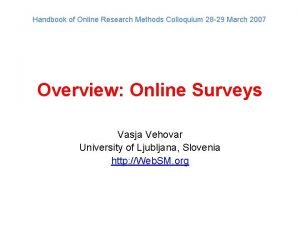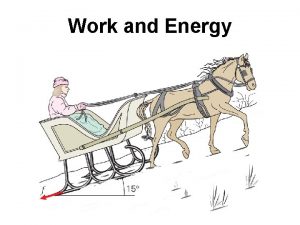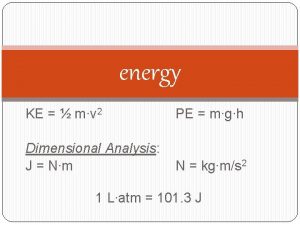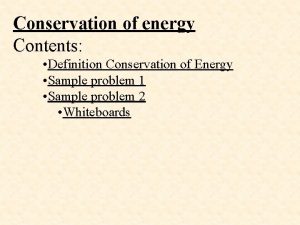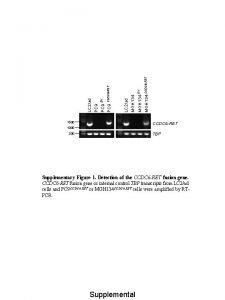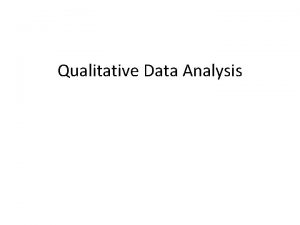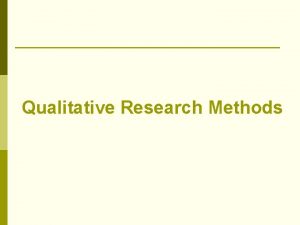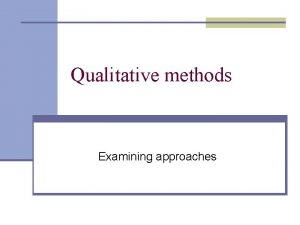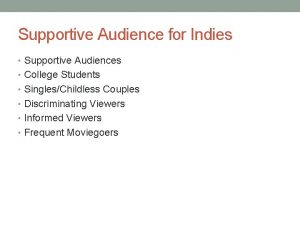QUALITATIVE METHODS MGH Workshop on Methods in Supportive









































- Slides: 41

QUALITATIVE METHODS MGH Workshop on Methods in Supportive Oncology Research Elyse R. Park, Ph. D. , M. P. H Associate Professor in Psychiatry Massachusetts General Hospital/Harvard Medical School

QUALITATIVE PAPERS IN Pub. Med Year Pub. Med Pubs Qualitative research Ratio Pubs (per 1, 000 articles) 1990 1994 1998 2000 2004 2008 2010 2012 399, 836 423, 431 461, 188 521, 038 622, 978 817, 189 930, 796 1, 023, 382 38 86 150 217 922 1920 2676 3013 0. 10 0. 20 0. 33 0. 42 1. 48 2. 35 2. 87 2. 94

What is your Study Question? Question What (exploratory) What (how many, how much) Who & Where Why & How (explanatory) Strategy Qualitative Quantitative Qualitative

Type of Research Questions • Quantitative: HYPOTHESES • Qualitative: PROPOSITIONS

Purposes of Qualitative Research • Stand alone – hypothesis development, learn about a cancer population • To inform survey development • To elucidate survey findings • To inform program development (curriculum, interventions)

Qualitative Data to Elucidate Study Findings • Analysis of Temel Early PC RCT (NEJM, 2010) – Qualitative analysis of PC clinician documentation of all visits with patients receiving early PC Elements Emphasis in illness trajectory In initial visits Throughout In later visits Relationship and rapport building Addressing symptoms Addressing coping Establishing illness understanding Discussing cancer treatments End-of-life planning Engaging family members Yoong et al. , Annals of Internal Medicine, 2013

Using Qualitative Data to Inform Intervention Development Rationale: Palliative care clinicians (PCC) are susceptible to burnout. To inform the development of a targeted resiliency program for PCCs, we conducted in depth interviews to: • Explore common stressors • Understand training needs • Identify current coping strategies Perez G, Journal of Palliative Medicine, In Press

Linking Qualitative Data With Surveys Qualitative data… Contribute to the creation of survey items by: 1) Capturing survey domains 2) Determining dimensions 3) Item wordings (cultural idioms) • Augment testing of an instrument • Help generate hypotheses • Explain aspects of findings that are puzzling

Using Qualitative Data to Inform Survey Development SURVEY GOAL: To develop a national survey to assess residents’ attitudes about crosscultural care: 1) Perceptions of preparedness to deliver care to diverse populations 2) Educational experiences 3) Educational climate Weissman et al. , JAMA, 2005 QUALITATIVE STUDY GOAL: To elucidate the 3 survey domains Park et al. , Academic Medicine, 2005

Mixed Methods Design 1) Convergent: separate quantitative and qualitative data collection, separate analyses & comparison of the two 2) Explanatory: quantitative data collected first; qualitative data collection is subsequent 3) Exploratory: qualitative data collection explores a topic and analysis results are used to build a quantitative data collection procedure

Racial Disparities in Coping with Lung Cancer • • Use Can. CORS dataset to compare rates of depression in non-Hispanic Black and White lung cancer patients and identify rates of mental healthcare utilization Conduct in-depth interviews with patients from the Dana-Farber Harvard Cancer Center to characterize Can. CORS findings Traeger L. et al. , JCO 2014

Qualitative Interview Domains Quantitative: • Questionnaire derived from Phase 1 Can. CORS items Qualitative: • Perceptions of depression & cancer • Factors influencing interest in psychological services • Perceived barriers to psychosocial service utilization • Intervention preferences

Mixed Methods Data Collection Park et al. , JCO, 2015

Qualitative Data Collection Individual in depth interviews Narratives Focus group interviews Consensus methods Participant observation Case studies Document analysis

Advantages of Focus Groups • Suitable for groups with low formal education • Time efficient • Instant verification of data • Comfort level of a group • Members of the same community can enrich each others participation

Disadvantages of Focus Groups • Limited number of questions • Facilitator needs special skills • Results are harder to analyze • Some people don’t do well in groups • Public rather than private views are shared • Members of community might not want to share views in a group setting

Interview Guide Structure • 3 Levels: Un—Semi—Highly • Structure determines the: – Content – The number of questions – Sequencing

Developing The Interview Guide Unstructured • 1 -2 broad topics Structured • 4 -5 distinct topics or questions • distinct probes for each topic • specific order • order from general to specific • begin with most important questions • builds in transitions among topics

Pilot Testing The Guide • Are the questions phrased in a way that will elicit the information that you’re seeking? • Are the questions clear? • Are the questions biased? • Are any of them closed ended? • Do any need expansion? • DID YOU use ANY double negatives?

Qualitative Sampling Purposeful/purposive sampling Particular settings, persons, or events are deliberately selected according to 1) research purpose and 2) theoretical development Stratification: deliberate selection of participants based on certain criteria Patton, 1990; Miles & Huberman, 1994

Saturation • Saturation occurs when no new information (redundancy) is obtained (Lincoln & Guba, 1985; Patton, 1990) • Through the constant comparison of data (Glaser & Strauss, 1967, Cutcliffe & Mc. Kenna, 2002) - researcher determines saturation by comparison of data analyzed to additional data • Recurrent patterns and themes are seen

Constant Comparison: Glaser & Strauss • • • Begin collecting data. Look for key issues, recurrent events, or activities that become categories for focus. Collect data of the incidents of the categories of focus Write about the categories and all the incidents Create an model to discover processes and relationships. • Engage in sampling, coding, and writing as the analysis focuses on the core categories Glaser & Straus, 1978

Data Analysis Inductive: categories and themes emerge (grounded theory) from data Deductive: processes of “fitting” the data into categories and themes (apriori codes -framework analysis)

Coding OPEN CODING • Code or label words and phrases found in the transcript or text AXIAL CODING • Create themes or categories by grouping codes or labels given to words and phrases

What Are You Coding? • The Word • Internal Consistency • Frequency • Extensiveness • Intensity • What Was Not Said

The Behavioral Effects of Lung Screening 1) To determine whether lung screening is a “cue to action. ” 2) To elucidate risk perceptions and underlying behavior change determinants for lung cancer. 3) To explore post-screening behavioral intentions and changes. Park et al. , NTR, 2014

Health Belief Model Cue to Action Perceived Severity Perceived Benefit Perceived Risk Confidence

Deductive Coding HBM criteria Lung Screening participants Cue to action Screening not a trigger Risk beliefs High risk, but perceptions not well formed Perceived severity High severity/disconnected from causality Confidence to change behavior Low Worry (Self Regulatory Model) Low Park et al. , NTR, 2014

Characteristics of Qualitative Data Analysis • Systematic and verifiable • Theory driven • Iterative process • Flexible to alternate views • Includes a system to handle incongruencies between coders

Audit Trail Auditability: clear account of the research process so that reader can judge the dependability of the study (aka decision trail) Lincoln & Guba, 1985

Keeping Track Of The Analysis Process • Theories that influenced the data analysis • How data were organized • Multiple coder strategy • How you conducted data reduction • How conclusions were drawn & verified

Ways To Enhance Validity • Respondent validation • Triangulation: Using multiple investigators, theories, or methods to gather data • Attending to cases that deviate from theory • Supervision and peer review of analysis

Consistency & Dependability Assuring that information collected is accurate & consistent. • Pretesting & standardizing instruments • Team interviewing • Tape recording • Debriefing • Participant feedback • Multiple coders/establishing inter-rater reliability • Coding with content analysis • Keeping an audit trail


Survivors’ Perceptions of Health Insurance: Initial Coding Framework COVERAGE CHARACTERISTICS AND SATISFACTION • Access satisfaction – Satisfied – Not satisfied • Problems with access – Physician not in network – Plan accepted by a limited number of physicians – Distance to providers DIFFICULTIES AND GAPS IN COVERAGE • Ever had a period that was not covered? – Yes • Reason for gap – Affordability – Change in job/job status – Change in dependent status – Other POSSIBLE ATTRIBUTES • Insured (Y/N) • Gender • Cancer Recurrence (Y/N)


Advantages of Computing • Ability to deal with large amounts of data • Reducing time needed for manual handling tasks • Increased flexibility & thoroughness in handling data • More rigorous analysis of data • More visible data analysis audit trail St John & Johnson, 2000

Disadvantages of Computing • Focus on quantity vs. meaning • Analysis can become rigid & “homogenized” • Data can become too reduced/too much focus on coding & retrieval • Distances researcher from data/context • Time spent learning use • Pressures to use/commercialism St John & Johnson, 2000

PUBLISHING CHECKLIST • Collect demographics • Publication intentions included on consent form • Record recruitment efforts/response rate Explain rationale for sampling • • Pilot guide/data collection instrument • Analyze by sampling plan • Review reliability & validity • Expert review

Robert Wood Johnson Qualitative Research Guidelines Project http: //www. qualres. org/index. html

Experimentalistics try to control it. Statisticians count it. Interviewers ask questions about it. Observers watch it. Participant observers do it. Qualitative inquirers find meaning in it. -From Halcolm’s Laws of Inquiry
 Qualitative analysis skills
Qualitative analysis skills Disadvantage of qualitative research
Disadvantage of qualitative research Qualitative research methods
Qualitative research methods Integrating qualitative and quantitative methods
Integrating qualitative and quantitative methods Methodology errors
Methodology errors Sampling methods in qualitative and quantitative research
Sampling methods in qualitative and quantitative research Qualitative research methods
Qualitative research methods What is the characteristics of qualitative research?
What is the characteristics of qualitative research? Teacher as a researcher
Teacher as a researcher Purposive sampling
Purposive sampling Qualitative forecasting methods
Qualitative forecasting methods Visual methods in qualitative research
Visual methods in qualitative research Methodology
Methodology Qualitative analysis political science
Qualitative analysis political science Nyelvi szintek
Nyelvi szintek Eg=mgh
Eg=mgh Si units of work
Si units of work Work energy theorem
Work energy theorem Bacterial vaginosis under microscope
Bacterial vaginosis under microscope Gpe=mgh
Gpe=mgh Mgh formula
Mgh formula P.e=mgh dimensions
P.e=mgh dimensions Epg = m.g.h
Epg = m.g.h Mgh physik
Mgh physik P= mgh/t
P= mgh/t Gpe= mgh
Gpe= mgh Mgh formula
Mgh formula Mgh
Mgh Mgh haven
Mgh haven Mgh = 1/2kx^2
Mgh = 1/2kx^2 Ep= mgh
Ep= mgh Mgh.harvard.edu
Mgh.harvard.edu How to increase potential energy
How to increase potential energy Mgh
Mgh Eric rosenberg md
Eric rosenberg md Eg = mgh
Eg = mgh Principle of supportive relationship
Principle of supportive relationship Supportive
Supportive Productive reactions to fear include freezing
Productive reactions to fear include freezing Supportive stance position posture proximity
Supportive stance position posture proximity Functions of indirect retainer
Functions of indirect retainer Fortune society scattered site housing
Fortune society scattered site housing






